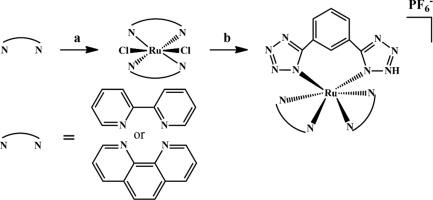Journal of Inorganic Biochemistry ( IF 3.8 ) Pub Date : 2020-08-21 , DOI: 10.1016/j.jinorgbio.2020.111233 Hongliang Xu 1 , Xujing Zhang 2 , Xinchen Li 3 , Xiaochuan Zhang 4 , Jun Deng 4 , Dengfeng Zou 2 , Jie Yang 5

|
Design and preparation of photosensitizers (PSs) play an important role in photodynamic therapy (PDT). PDT mainly relies on the production of toxic reactive oxygen species (ROS) of the PSs. Conventional fluorophores, however, often suffer from aggregation caused quenching (ACQ), which limits the potential of PSs as fluorescent imaging agents. Molecules with aggregation-induced emission (AIE) properties maintain high fluorescence and dispersity in aqueous solutions, overcoming the ACQ effect. Ruthenium (II)-based AIE compounds are highly biocompatible molecules and can be used for response cell imaging. In the current study, two novel Ru(II)-based AIE compounds with main ligands 1,3-di(2H-tetrazol-5-yl)benzene (Hphbtz) by changing auxiliary ligand 2,2′-bipyridine (bipy) and 1,10-phenanthroline (phen) have been successfully synthesized and characterized, [Ru(Hphbtz)(bipy)2][PF6] (1) and [Ru(Hphbtz)(phen)2][PF6] (2). The NPs show strong intra-cellular fluorescence and also simultaneously exhibited potent cytotoxic activity. These compounds can self-assemble to form nanoparticles (NPs) by nanoprecipitation. The compounds are found to exhibit a high AIE property with emission maxima at 353 nm and 380 nm, respectively. And the compounds have the low IC50 (half maximal inhibitory concentration) of only 15 μg/mL (1.94 μM) and 13 μg/mL (1.58 μM) on HeLa cells, respectively. Meanwhile, negligible dark toxicity has been also observed for these NPs. The results show that [Ru(Hphbtz)(bipy)2][PF6] (1) and [Ru(Hphbtz)(phen)2][PF6] (2) NPs can inhibit cell proliferation in vitro, and may be potential candidates for photodynamic therapy.
中文翻译:

两种具有聚集诱导发射的 Ru(II) 化合物作为有前途的光动力治疗光敏剂
光敏剂(PSs)的设计和制备在光动力疗法(PDT)中发挥着重要作用。PDT 主要依赖于 PSs 有毒活性氧 (ROS) 的产生。然而,传统的荧光团经常受到聚集引起的猝灭 (ACQ) 的影响,这限制了 PS 作为荧光成像剂的潜力。具有聚集诱导发射 (AIE) 特性的分子在水溶液中保持高荧光和分散性,克服了 ACQ 效应。基于钌 (II) 的 AIE 化合物是高度生物相容性的分子,可用于响应细胞成像。在目前的研究中,通过改变辅助配体 2,2'-联吡啶 (bipy) 和1、2 ][PF 6 ] ( 1 ) 和[Ru(Hphbtz)(phen) 2 ][PF 6 ] ( 2 )。NPs 显示出强烈的细胞内荧光,同时还表现出有效的细胞毒活性。这些化合物可以通过纳米沉淀自组装形成纳米颗粒 (NPs)。发现这些化合物表现出高 AIE 特性,发射最大值分别位于 353 nm 和 380 nm。并且这些化合物对 HeLa 细胞的IC 50(半数抑制浓度)低,分别仅为 15 μg/mL (1.94 μM) 和 13 μg/mL (1.58 μM)。同时,还观察到这些 NPs 的暗毒性可以忽略不计。结果表明[Ru(Hphbtz)(bipy) 2 ][PF 6] ( 1 ) 和[Ru(Hphbtz)(phen) 2 ][PF 6 ] ( 2 ) NPs 可以在体外抑制细胞增殖,并且可能是光动力疗法的潜在候选者。











































 京公网安备 11010802027423号
京公网安备 11010802027423号